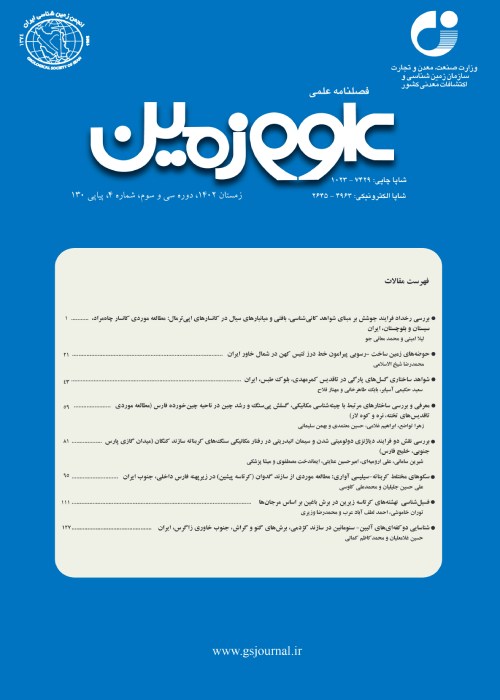Geochemical Exploration and Heavy Mineral Study of Stream Sediments in Barandagh Quadrangle, NE of Zandjan, Iran
Author(s):
Abstract:
Barandagh quadrangle (1:50000), a part of Tarom-Hashtjin polymetallic district, is located in NE of Zanjan and SE of Ardabil. The results of preliminary regional geochemical explorations have led to the discovery of anomalous areas for a variety of elements. The anomalies were verified by studies on heavy minerals in stream sediments and mineralized and altered samples taken from the surface outcrops. The identified heavy minerals are hematite, goethite, pyrite, barite, ilmenite, native copper, native zinc, native lead, malachite, molybdenite, micaceous hematite, limonite, cerussite, galena, smithsonite, marcasite, chrysocolla, rutile, zircon, pyroxene, amphibole, and apatite. The identified heavy metallic minerals are principally affiliated with zones of widespread alterations and dispersed veinlet-type mineralization. Chemical analysis of some litho-geochemical samples from the anomalous areas shows noticeable assays for elements such as Ba, Zn, Cu, Sr, Mo, and Be. The majority of anomalous areas are intimately associated with alteration zones in the region. Based on field evidence and mineralogical studies, the alterations are categorized into two discrete types, (1) acid-sulfate alterations (e.g., silisified, alunitized, advanced argillic, phyllic, and propylitic) which are related to shear zones and (2) alterations developed in neutral pH conditions (e.g., argillic, calc-silicate-bearing, and zeolitized) cropped out along the margin of Ghezel-Ozan river. Combination of the overall obtained data from chemical analyses, study of the heavy minerals, petrography of mineralized and altered samples, and field relations led to identification of ten anomalous spots that some, in south and along the margin of the Ghezel-Ozan River, have more potential for ore deposits. The comparison of final anomaly map with the map of fault density depicts that there exists a good correlation between them that may indicate that the fault and shear zones have played a crucial role in creation of these anomalies. Finally the overall results obtained from geochemical investigations in Barandagh show that the identified anomalies belong chiefly to elements such as Sn, Sb, As, Ag, W, Au, Bi, and Pb that can be used as tracer for exploration of epithermal gold and silver and of polymetal (Au, Ag, Cu, Pb, Zn) deposits.
Language:
Persian
Published:
Geosciences Scientific Quarterly Journal, Volume:16 Issue: 62, 2007
Page:
102
magiran.com/p431172
دانلود و مطالعه متن این مقاله با یکی از روشهای زیر امکان پذیر است:
اشتراک شخصی
با عضویت و پرداخت آنلاین حق اشتراک یکساله به مبلغ 1,390,000ريال میتوانید 70 عنوان مطلب دانلود کنید!
اشتراک سازمانی
به کتابخانه دانشگاه یا محل کار خود پیشنهاد کنید تا اشتراک سازمانی این پایگاه را برای دسترسی نامحدود همه کاربران به متن مطالب تهیه نمایند!
توجه!
- حق عضویت دریافتی صرف حمایت از نشریات عضو و نگهداری، تکمیل و توسعه مگیران میشود.
- پرداخت حق اشتراک و دانلود مقالات اجازه بازنشر آن در سایر رسانههای چاپی و دیجیتال را به کاربر نمیدهد.
In order to view content subscription is required
Personal subscription
Subscribe magiran.com for 70 € euros via PayPal and download 70 articles during a year.
Organization subscription
Please contact us to subscribe your university or library for unlimited access!


